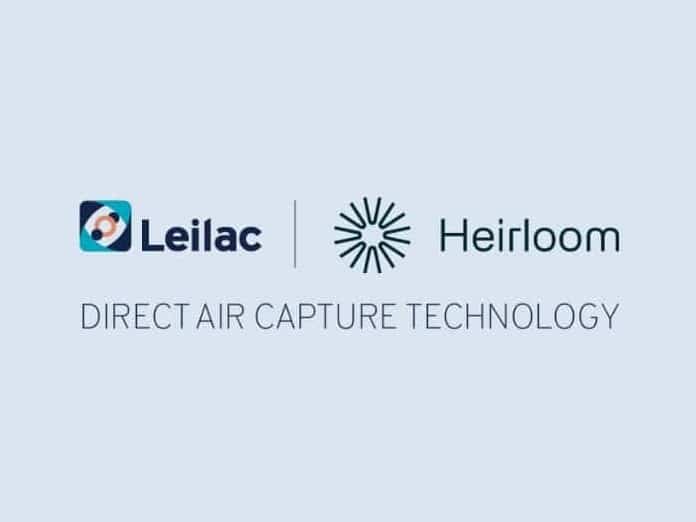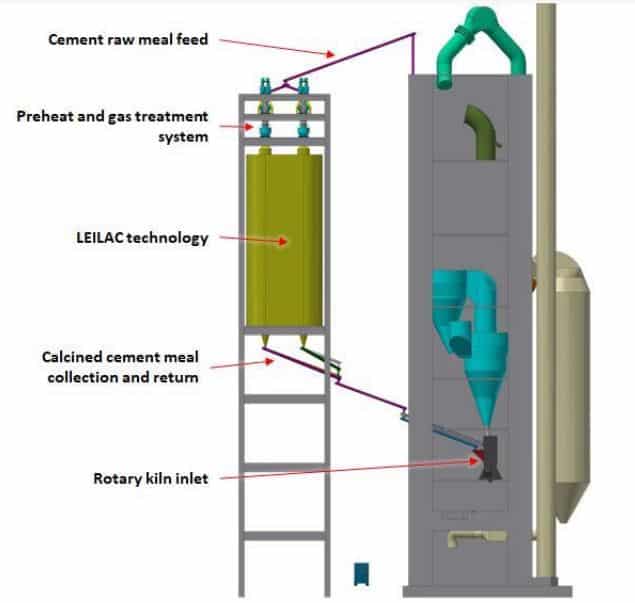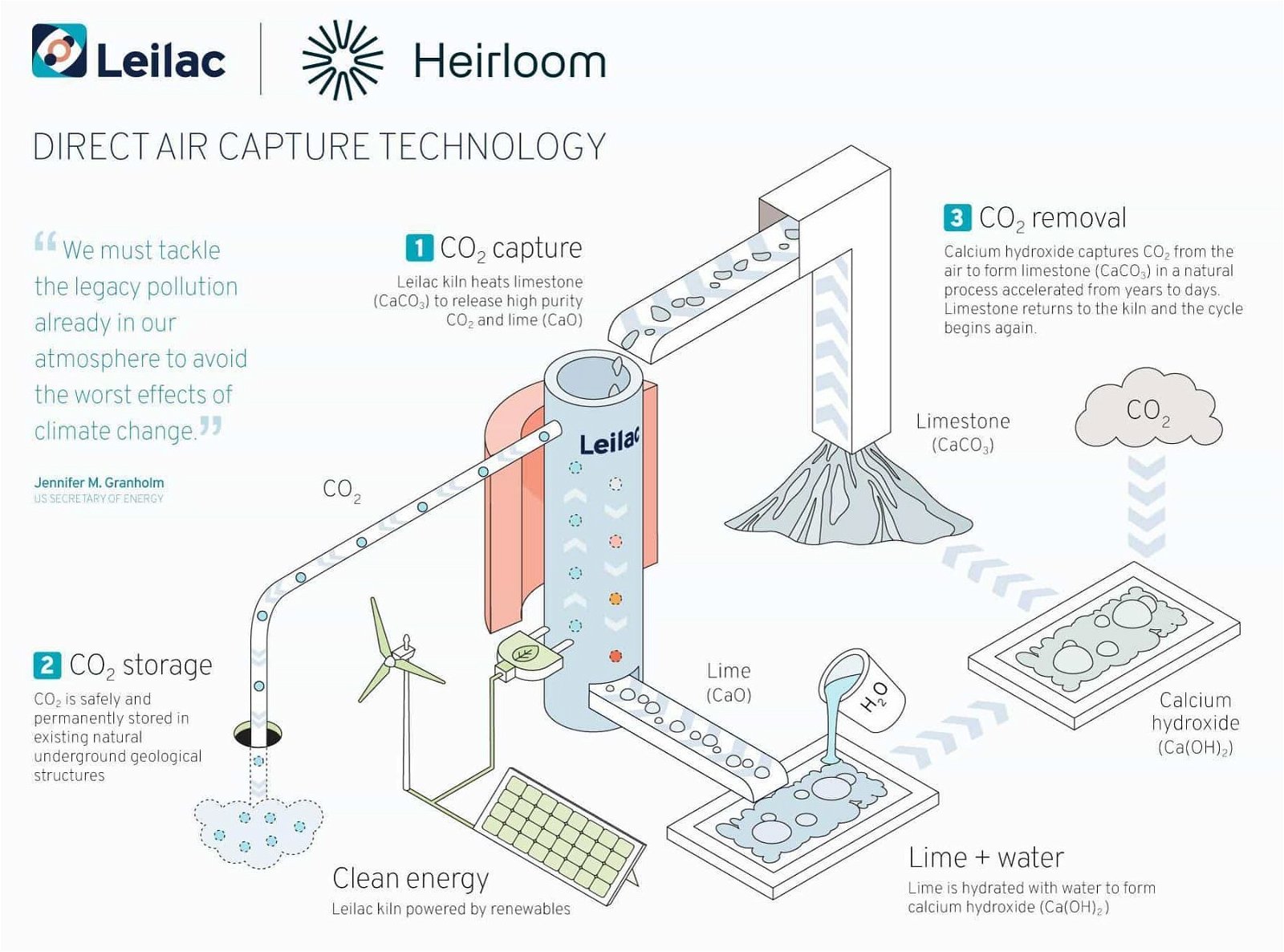A direct air capture company, Heirloom, has entered into an agreement with a decarbonization tech developer, Leilac, where the latter’s kiln tech will be integrated in Heirloom’s DAC solution.
The partnership between the two companies will combine the leading climate tech, providing an innovative, highly efficient and scalable solution to removing carbon through Direct Air Capture or DAC. The Memorandum of Understanding they signed is a collaboration agreement ready for execution in the coming weeks.
Shashank Samala, CEO of Heirloom, remarked:
“We’re incredibly excited about incorporating Leilac’s world-leading electric kiln technology into our Direct Air Capture facilities because it will accelerate our efforts to capture 1 billion tons of CO2 from the atmosphere by 2035 owing to its highly modular and energy-efficient design.”
Also commenting on the partnership, Leilac CEO Daniel Rennie said:
“Heirloom and Leilac are well matched… Heirloom uses low-cost and abundant limestone, which Leilac’s technology is specifically designed for. Both technologies are modular, easily scalable and can be renewably powered.”
Heirloom’s Direct Air Capture Tech
Heirloom offers a direct air capture solution which is basically speeding up a process that already happens naturally. The company is using a powder made from crushed limestone, a rock that forms using carbon dioxide.
In nature, this carbon mineralization process takes millions of years, but Heirloom’s DAC tech does it in only three days. They are mixing the powder with water, which then acts like a sponge that absorbs CO2 quickly.
The captured CO2 can then be safely and permanently stored for a long period of time. With such technology, Heirloom is developing the fastest path to low-cost, permanent CO2 removal with limestone.
With a cost of about US$10-$50/tonne, limestone is inexpensive and easy to source. Combined with a highly-modular and easy-to-manufacture facility, Heirloom’s DAC solution won over the Musk-funded XPRIZE Carbon Removal competition last year.
Heirloom, whose investors include Bill Gates-backed Breakthrough Energy Ventures, Microsoft, and current Leilac shareholder Carbon Direct Capital Management, aims to remove 1 billion tons of CO2 by 2035.
So, Why DAC?
Decarbonizing all sectors is critical to meeting global net zero goals by 2050. But to achieve that, decarbonization economy-wide won’t be enough. The world also has to address the CO2 already dumped in the air.
Climate experts project that carbon removal of about 1 to 10 billion tonnes each year can help tackle residual emissions. More importantly, it can help reach net negative emissions and bring down global temperatures to 1.5°C.
Modular, scalable and low cost direct air capture tech that Heirloom provides, alongside geological carbon storage, offers a way to remove CO2 at the gigatonne scale.
So, where does Leilac’s decarbonization tech fit in?
Leilac’s Industrial Decarbonization Tech
The reformed limestone courtesy of Heirloom’s DAC will be fed into a Leilac kiln. The kiln will separate the CO2 from limestone using exclusively renewable energy sources.
All the CO2 captured from the air then mineralizes, either by binding it with rocks or other materials. Or it can also be stored away deep underground where it can’t escape back into the atmosphere.
This calcination tech by Leilac uses a unique indirect heating system that doesn’t need additional chemicals or processes. It keeps the process CO2 emissions pure, eliminating the need to separate gases from gases.
As such, it makes a perfect match for limestone-based direct air capture of Heirloom.
Leilac’s decarbonization tech was developed for, and in partnership with, the cement and lime industries. It provides an efficient solution for abating and separating unavoidable process emissions in producing cement and lime.
This technology proves successful at pilot scale, such as through its pilot plant, Leilac-1, as well as its three smaller electric units. Leilac-1 began operating in 2019 with a capture capacity of 25,000 tonnes of CO2/year. It’s the biggest carbon capture installation for cement outside China.
Leilac-2, shown above, is a demo plant capable of capturing 100,000 tonnes of CO2/year is due to open next year.
Full-scale installations of Leilac’s tech at cement plants with CO2 capture capacities of ~1 million tpa of CO2 are under study. Right now, Leilac’s CO2 capture capacity is more than 2x the current combined capacity of all DAC facilities worldwide.
Heirloom and Leilac’s Combined DAC Approach
The direct air capture tech of Heirloom uses lime through a novel carbonation process. The addition of Leilac’s kiln tech will further hasten the CO2 removal solutions for industrial emissions.
The integrated Heirloom and Leilac DAC solution will run 100% using renewables and clean fuels to deliver the maximum net carbon reduction. Their partnership leverages eight years of significant investment to advance the DAC industry.
As how Rennie puts it:
“The collaborative and cooperative approach outlined in this agreement [MOU] aims to accelerate the learning, synergies and steps to scaling that are needed to achieve our global climate ambitions and commitments.”



